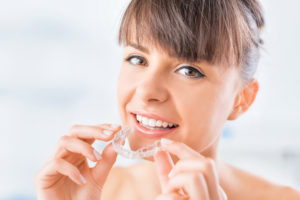Blog
Brushing and Flossing: Does Order Matter?
 Most of us are well aware that we should be brushing and flossing our teeth every day. What may not be quite so clear is which task should come first. Here, we discuss the points of interest in this conversation.
Most of us are well aware that we should be brushing and flossing our teeth every day. What may not be quite so clear is which task should come first. Here, we discuss the points of interest in this conversation.
The Debate
Every conversation has two sides. When talking about the order in which brushing and flossing take place, there is one side that states that brushing is what cleans the teeth of most of the plaque that has accumulated, even in areas that are semi-difficult to reach. Another side argues that flossing loosens or removes plaque from the gum line and in between teeth, so should be done first. This side also states that, by flossing first, the toothbrush bristles and toothpaste have more cleaning action on teeth.
The Details of Oral Care
Teeth need to be cleaned every single day. Brushing does not need to exceed twice-a-day sessions; usually morning and night. Flossing is a once-a-day task but is no less vital to oral health than brushing. If you don’t floss for even a few days, plaque forms where you can’t see it, and it begins to harden. Hardened plaque, called tartar, can’t be flossed away. It will stay on enamel until removed by the dentist. Furthermore, forgetting to loss paves the way to bad breath.
Another important detail of oral care is that the back of the tongue needs to be cleaned. However, it isn’t ideal to brush the back of the tongue with your toothbrush. Doing so collects bacteria from the tongue and leaves it on the instrument you use to clean your teeth. Basically, brushing your tongue just creates a cycle for bacteria. A better idea is to get a tongue scraper from a pharmacy or drug store and gently run it from the back of the tongue to the front.
Benefits of Brushing and Flossing
There is a lot of information online about the dangers of gum disease. The primary advantages of daily brushing and flossing are that these activities significantly reduce your chance of getting cavities or infected pulp (which needs a root canal). Regular care also inhibits bacteria from invading the gums and causing hidden infection. It isn’t just gum disease and cavities that can be prevented with proper oral care. Studies suggest that a healthy mouth also supports a healthy body that has a lower risk of stroke, chronic health conditions, heart disease, and even dementia.
So what’s the answer to the initial question? The answer is, it doesn’t matter whether you brush or floss first. Just remember to do both every day. Your Burke dentist can support your daily oral care with thorough exams and professional cleanings. Call (703)-935-2879 to schedule a visit with us.
Posted on September 30th, 2018
Why Wearing a Retainer is So Important
 After braces come off, even if you’ve been treated with Invisalign, you may wish for a break. More time with yet another fixture supporting teeth can feel restrictive. However, the moment braces come off, your dentist will fit you with a retainer. Here, we discuss why, and what happens if you don’t wear your retainer as directed.
After braces come off, even if you’ve been treated with Invisalign, you may wish for a break. More time with yet another fixture supporting teeth can feel restrictive. However, the moment braces come off, your dentist will fit you with a retainer. Here, we discuss why, and what happens if you don’t wear your retainer as directed.
Why a Retainer is Needed
A retainer is a device that runs along the arch of teeth to keep them in place after orthodontic treatment. Historically, retainers have been removable. More recently, though, fixed retainers have become available. They are also much more discreet than they once were. Many of the retainers that are made today are clear, just like Invisalign, or are situated behind the teeth where the single wire cannot be seen.
After your last Invisalign tray or once braces come off, a new model of your teeth is made using impressions. From this model, your retainer can be made to fit perfectly to prevent teeth from shifting back toward their original position.
Why Teeth Shift
For the first year after orthodontic treatment is completed, teeth are likely to shift back into misalignment. The reason this can happen is that, at this time, the ligaments that hold teeth in place are more flexible as a result of the pressure placed on teeth during Invisalign or braces treatment. If teeth are “set free” with no safeguards, the flexibility of the periodontal ligament will allow them to shift.
How to Wear a Retainer
One of the questions patients have is if they will have to wear a retainer forever. The answer isn’t a simple yes or no.
Initially, retainers are prescribed for full-time wear. After the first year of use, it is possible to reduce wear to nighttime only. This can continue for another year. By this time, teeth should be much more stable in their new position. Then, a retainer can be worn a few nights a week to prevent the slight shifts that can naturally occur with age.
If you have questions about straightening your teeth with Invisalign and what that would entail for you, call our Burke office at (703)-935-2879. We love helping patients love their smiles!
Posted on September 15th, 2018
Snacking Can Be a Hazard to Your Smile
 Back-to-School time has many parents on the hunt for the perfect snacks for their school-aged children. Snacking is a vital part of life for people of all ages, but especially for children. When we consume something small and healthy between larger meals, we can regulate blood sugar, mood, and our energy level. While snacks were initially intended for such positive purposes, we have somewhat fallen off the wagon. Snacking on cookies, chips, and soda could do much more harm than good. Here, we discuss how snacking can harm teeth and what to do to create a win-win snacking situation for yourself and those you love.
Back-to-School time has many parents on the hunt for the perfect snacks for their school-aged children. Snacking is a vital part of life for people of all ages, but especially for children. When we consume something small and healthy between larger meals, we can regulate blood sugar, mood, and our energy level. While snacks were initially intended for such positive purposes, we have somewhat fallen off the wagon. Snacking on cookies, chips, and soda could do much more harm than good. Here, we discuss how snacking can harm teeth and what to do to create a win-win snacking situation for yourself and those you love.
Snacking and Dental Plaque
As much as experts recommend snacking on fresh fruits and crunchy vegetables, this isn’t often what people reach for. A lot of the snacks that are popular contain sugar, which creates a risk of plaque accumulation around the gum line. Sure, cookies and coffee might sound perfect for an afternoon pick-me-up, but the sugar in one is compounded by the acidity in the other, and the results could be a significant increase in the risk for tooth decay. Sugar residue is invisible, just like the plaque it supports. As this residue sits on enamel, it feeds bacteria and leads to an acidic byproduct that softens enamel. Softened enamel is the precursor to cavities.
Snacking and Erosion
Snacking is supposed to build you up. To hear that your snacks might wear down your teeth can take the air right out of your pleasure balloon. Not to worry; snacking can be pleasurable and healthy. The issue with some snacks, like that cup of coffee or fresh, crispy pickle, is that acidic ingredients can also soften enamel. In recent years, dentists have seen a surge in tooth erosion, which is the large-scale wearing down of the hard, outer material on teeth. Erosion can lead to discoloration as well as dental decay and sensitivity.
Save Your Smile with Simple Habits
You don’t have to stop snacking to save your smile. As much as possible, reach for crunchy, fresh foods that naturally cleanse debris off of your teeth. When you indulge in any snack, rinse your teeth with water (no brushing for thirty minutes) to dilute sugars and acids that may otherwise harm enamel.
Your Burke dentist is on your side against dental decay. Schedule checkups and cleanings for your family at (703)-935-2879.
Posted on August 30th, 2018
Dental Implants Cost: Are We Looking at the Right Detail?
 If you’re like most people, you want to feel a sense of reward when you spend money. Even the most conscientious among us do. There’s something much more gratifying to purchasing a shiny new watch than a shiny new tooth (unless we’re talking about professional teeth whitening). Tooth replacement due to injury or disease is another story. We expect our natural teeth to last. When one or more teeth fail, we might feel out-and-out robbed of our great smile – and our hard-earned cash.
If you’re like most people, you want to feel a sense of reward when you spend money. Even the most conscientious among us do. There’s something much more gratifying to purchasing a shiny new watch than a shiny new tooth (unless we’re talking about professional teeth whitening). Tooth replacement due to injury or disease is another story. We expect our natural teeth to last. When one or more teeth fail, we might feel out-and-out robbed of our great smile – and our hard-earned cash.
Tooth loss isn’t something that can be ignored. There are steeper costs to not replacing a tooth than there are if you choose tooth replacement carefully with the help of your dentist. Here, we touch on how to evaluate the actual cost of dental implants by observing the value of your investment in your well-being.
Invest in Longevity
All dental treatment comes at a cost, and dental implant treatment is typically the most “costly” of all available tooth replacement options. That is, until the focus shifts to value. One of the ways to observe the value of dental implants is to compare the longevity of results to those obtained with dental bridges and dentures.
Dental prosthetics like crowns, bridges, and dentures have an expected lifespan. The longevity of dentures ranges from 5 to 15 years, with 8 being the average. A dental bridge can last up to 15 years, or as little as 5. Dental implants are prostheses that are inserted into the jawbone. Within months after initial insertion, they become encased in bone. This fusion allows them to last for several decades with good periodontal care.
Invest in You
When faced with the need for new teeth, consider the money that you spend an investment in your future well-being and quality of life, because that’s exactly where you will see your reward. Tooth replacement may put teeth back where they should be, but there’s much more that stems from the structural restoration. Healthy, natural teeth can bite into foods and chew them thoroughly whether they are crunchy or chewy or dense. If artificial teeth cannot perform to the same standard, their value decreases. Many of the men and women who have replaced natural teeth with dental implants and affixed crowns, bridges or dentures express immense appreciation for the natural feel they get from their restorations.
Learn more about how dental implants can add value to your life. Call our Burke office at (703)-935-2879.
Posted on August 15th, 2018
Why Would My Tooth Hurt after a Dental Crown?
 One of the common questions that appears on internet searches is “why does my tooth hurt after a crown?” To experience pain after restorative treatment can be alarming and frustrating. The whole point of getting a crown is to stop the pain that may have resulted from an injury or bad cavity. If a dental crown was installed for a problem that was not painful to begin with, pain after a dental crown could be especially concerning. Here, we discuss why this may happen.
One of the common questions that appears on internet searches is “why does my tooth hurt after a crown?” To experience pain after restorative treatment can be alarming and frustrating. The whole point of getting a crown is to stop the pain that may have resulted from an injury or bad cavity. If a dental crown was installed for a problem that was not painful to begin with, pain after a dental crown could be especially concerning. Here, we discuss why this may happen.
Tooth Structure 101
Beneath the hard layer of enamel and a softer layer of dentin is a chamber of very soft tissue that is made up of blood vessels and nerves. This is called dental pulp. Because pulp is innervated, it will react to stimulation of all types. Sometimes that stimulation comes from the temperature of food, sometimes from infection, and sometimes the nerves of a tooth are stimulated by dental work.
The reason that most people need a dental crown is that a tooth has suffered trauma, infection or otherwise. When a tooth is prepared for a dental crown, the nerve may perceive additional injury. This is a double-whammy for a nerve that has become increasingly reactive to stimuli. As a result of preparation for tooth repair, the tissues at the center of the tooth may become inflamed and may stay that way for some time.
In many cases, the tooth just needs some time to calm down. If pain develops shortly after getting a dental crown, give it a few days to see if it resolves on its own. Comfort should improve with over-the-counter medication. If pain worsens or does not go away after several days, you need to see your dentist. You may need:
A crown adjustment
After a crown has been affixed, we do a bite assessment to check the height and seating of the new restoration. In many cases, this is done after the nerves have been numbed with local anesthetic. Therefore, it is possible that pain from a dental crown is related to its situation in the mouth. Maybe one point of the dental crown is hitting the opposing tooth too strongly. We can check the height of the crown when you are not numbed to confirm whether or not your pain has to do with a structural problem.
A root canal
Sometimes, the inflammation that occurs in a tooth nerve after dental crown treatment doesn’t go away. This is impossible to predict, but it is treatable. If pain persists after getting a dental crown, or it gets worse, it could be an indication that the nerve is not going to calm down and that it will eventually die. Root canal therapy can be performed in this instance to remove the inflamed tissue and resolve pain. If this type of dental crown pain is not treated, the tooth may be lost, or infection may develop in the form of an abscess.
Are you experiencing dental pain? We can help. Call (703)-935-2879 to schedule your visit with us.
Posted on July 30th, 2018
A Straight Smile isn’t Only a Beauty Thing
 There is a lot of conversation going on about the value of an attractive smile. We’re happy to get in on it by helping patients in the Northern Virginia area take advantage of proven treatments like Invisalign. Taking steps to correct misalignment is excellent for the appearance of the smile. More than that, a straighter smile can also mean better health.
There is a lot of conversation going on about the value of an attractive smile. We’re happy to get in on it by helping patients in the Northern Virginia area take advantage of proven treatments like Invisalign. Taking steps to correct misalignment is excellent for the appearance of the smile. More than that, a straighter smile can also mean better health.
The American Dental Association has stated that straight teeth can reduce the risk of heart disease, diabetes, and stroke. Therefore, we cannot look at Invisalign or any other orthodontic treatment as purely cosmetic. Here, we point out how a straight smile can support a healthy body.
- Straight teeth are easier to clean than crooked teeth. As you may know, brushing and flossing are the best ways to prevent gum disease and cavities as well as the many secondary problems that may arise from them. When teeth are right next to each other or overlapping, it may be impossible to clean the tiny nooks and crannies in which plaque and bacteria have become concentrated.
- Straight teeth support gum health. With less plaque buildup and fewer places for bacteria to hide, gum health is much easier to maintain. Corrective treatment like Invisalign achieves proper spacing between teeth, which improves the effects of flossing, which decreases the risk of gingivitis and gum disease.
- Straight teeth are less prone to excessive wear and tear. Chewing and biting can cause teeth to wear down somewhat. This natural deterioration can occur much more quickly when teeth do not line up to chew. Alignment across the arch allows for the force of chewing to spread across the entire row of teeth rather than localizing on one or two surfaces.
- Straight teeth are good for the jaw. The brain expects teeth to meet when we bite and chew. If this doesn’t happen naturally, the brain asks the jaw to accommodate through certain movements. This causes stress on the joints and other structures that facilitate movement, which can ultimately lead to pain in the jaw, head, and neck. When we align teeth, we reduce the amount of work the jaw must do to break up food.
Learn more about Invisalign and how it can boost your overall health. Call our Burke office at (703)-935-2879.
Posted on July 15th, 2018
Fractures aren’t Just a Bone Thing
 When we hear the word “fracture,” we usually imagine an unexpected injury to a bone in the arm, leg, or another area of the body. This is not a word we might associate with our teeth. We should. Just like any bone in the body, a tooth can sustain an injury that leads to a fracture, or clean break. This type of damage typically occurs without warning, usually when something hard is bitten or chewed. Depending on the extent of the injury, tooth pain may not happen. However, a fracture is not something to leave unattended. Here, we discuss a few of the ways a fractured tooth might be treated.
When we hear the word “fracture,” we usually imagine an unexpected injury to a bone in the arm, leg, or another area of the body. This is not a word we might associate with our teeth. We should. Just like any bone in the body, a tooth can sustain an injury that leads to a fracture, or clean break. This type of damage typically occurs without warning, usually when something hard is bitten or chewed. Depending on the extent of the injury, tooth pain may not happen. However, a fracture is not something to leave unattended. Here, we discuss a few of the ways a fractured tooth might be treated.
Dental Bonding
We usually refer to dental bonding as a cosmetic treatment that covers small chips or other flaws. However, the dental bonding technique is also used restoratively. In this instance, we know the procedure as a tooth-colored filling. To repair a fractured tooth using this method, a slight amount of roughing may occur. This helps the composite material adhere to enamel. A tooth-colored mixture of glass and resin is then applied in thin layers and cured with light. The hardened material is comparable to enamel and therefore capable of strengthening the fractured tooth to decrease the risk of further damage.
Dental Crown
A dental crown may be necessary if a fracture has affected the layer of tooth material beneath enamel. This is a softer layer of matter and therefore more sensitive. A crown will cover the entire surface of the tooth to the gum line, buffering any stress that stems from biting and chewing. Dental porcelain is a standard crown material that looks and behaves like natural enamel, providing years of functional use.
Dental Implant
Severe tooth fractures may cause too much damage for the tooth to be saved. If the damaged tooth must be extracted, we can insert a tiny titanium post into the place where roots would be. This treatment induces bone growth around the post, leading to a new foundation for an artificial tooth to rest on top.
In our Burke office, patients can expect to receive care that suits their needs and their budget. For help repairing a tooth fracture or other dental problem, call (703)-935-2879.
Posted on June 30th, 2018
The Long and Winding Road of Dental Innovation
 Dentistry has had a longer lifespan than many of us could imagine. When we think of dental fillings, we may imagine the dark spots that a parent or grandparent has in their smile. Some people even know that there was a time when metal crowns were sought as a type of cosmetic smile enhancement. Rarely do we stop to consider what may have come before. When we do, though, we can see how long the road to innovation has been, and why we can be thankful for the dental techniques we have today.
Dentistry has had a longer lifespan than many of us could imagine. When we think of dental fillings, we may imagine the dark spots that a parent or grandparent has in their smile. Some people even know that there was a time when metal crowns were sought as a type of cosmetic smile enhancement. Rarely do we stop to consider what may have come before. When we do, though, we can see how long the road to innovation has been, and why we can be thankful for the dental techniques we have today.
The First Dental Fillings
Throughout the history of humankind, tooth decay has always been a risk. The more our usual dietary habits have changed, the more prevalent cavities have become. However, archeological finds have disclosed the existence of cavities in prehistoric remains. Prehistoric! Many hundreds of years ago, there were no dental drills; there wasn’t even a formal field of dentistry (that didn’t happen until the 1800s). However, based on evidence, there was at least one method of removing tooth decay. Fillings were another story altogether.
Dental filling material has been a bigger challenge. Early evidence points to attempts with beeswax and resin. Down the line, tin foil was tried. Gold became a common filling material in the early 1500s and was followed by amalgam shortly after that. Today, we repair cavities using sturdy composite material that looks like natural enamel and is supportive of structural soundness for many years.
Braces? Who Could Have Imagined!
The demand for straight, attractive teeth is so strong today that it’s hard to envision a time when this wasn’t the case. In fact, there may not have been. According to archaic texts and archeological evidence, attempts at straightening teeth existed as far back as ancient Rome. In the 1700s, one of the pioneers of modern dentistry wrote about a bandeau system that could correct misalignment. Just a few hundred years later, we are straightening teeth without braces at all. Invisalign, which corrects misalignment using semi-rigid plastic trays, has become one of the most popular methods of straightening teeth ever to exist.
There is no denying that a lot can change over time. We are proud to support our patients’ desires for healthy, attractive teeth by providing modern dental techniques with a proven track record. To learn more about our services or schedule your visit, call our Burke office at (703)-935-2879.
Posted on June 15th, 2018
Come On, Aligners for a Straighter Smile?
 As much as we have demonstrated our love for straight, attractive teeth, we have also resisted the conventional way of getting them. Orthodontic treatment has come a long way since its initial use. Way back when braces were first seen in the smiles of most teens in America, they were pretty obvious. The brackets that held the orthodontic wire were attached to bands. Metal bands. Metal bands that wrapped all the way around each tooth. That’s a lot of metal! The early model paved the way to brackets only, and then to invisible braces that were much more discreet. Now, we’ve pretty much got the best way to straighten teeth: Invisalign.
As much as we have demonstrated our love for straight, attractive teeth, we have also resisted the conventional way of getting them. Orthodontic treatment has come a long way since its initial use. Way back when braces were first seen in the smiles of most teens in America, they were pretty obvious. The brackets that held the orthodontic wire were attached to bands. Metal bands. Metal bands that wrapped all the way around each tooth. That’s a lot of metal! The early model paved the way to brackets only, and then to invisible braces that were much more discreet. Now, we’ve pretty much got the best way to straighten teeth: Invisalign.
The benefits of Invisalign are well-known at this point. Patients know that Invisalign has aligners instead of brackets and wires. They know that these aligners can be removed. They know that, when their aligners are in, they may not be noticed at all. Patients know they can eat whatever they want and they may even know they still need to wear a retainer once their treatment is complete. What they don’t know is that Invisalign might work for them.
People love the idea of getting straight teeth without braces, but many still don’t really believe it’s possible for them. Their misconception about Invisalign leads them to count themselves out. Don’t do this. Don’t make assumptions about what Invisalign can accomplish. If your teeth are not as straight as you’d like them to be, find out for sure how Invisalign works.
How Does It Work?
If you believe that braces could give you a straight smile, you have reason to believe that the same could be accomplished with Invisalign. The use of aligners doesn’t downgrade possibility. Beneath aligners, we see the same principles at work that we see beneath brackets and wires: gentle, consistent force. It’s that simple.
Invisalign works for patients who have crooked teeth, crowded teeth, even overlapping teeth. Invisalign has corrected overbites and underbites and cross-bites and more. It has been able to achieve excellent outcomes because each aligner is made using advanced software through which every little movement is predictable. From week to week, aligners guide tooth movement precisely as it needs to happen until teeth align as planned.
Aligners for a straight smile, really? Yes, really. Discover the possibilities in our Northern Virginia office, where your Invisalign treatment can be carefully planned. Call (703)-935-2879 to schedule your consultation.
Posted on May 30th, 2018
Is Soda Doing Your Teen a Disservice?
 We want our children to enjoy the benefits of having healthy teeth. That’s why we spend so much time during early childhood preparing and offering foods and drinks that support oral development. We teach our children how to brush and floss their teeth, and we take them to the dentist routinely so they don’t get cavities (hopefully). Of these habits, only one tends to continue once children reach their teen years.
We want our children to enjoy the benefits of having healthy teeth. That’s why we spend so much time during early childhood preparing and offering foods and drinks that support oral development. We teach our children how to brush and floss their teeth, and we take them to the dentist routinely so they don’t get cavities (hopefully). Of these habits, only one tends to continue once children reach their teen years.
While teens may be taken to the dentist regularly, they have taken over the responsibility of brushing and flossing. They are also more or less free to choose what they eat on a regular basis. According to a report from the Academy of General Dentistry, teens may benefit from more oversight as they transition into adulthood. This report has suggested that the fast-paced way of living that is common among most teens today is part of the reason why teens consume more soda and fast food than is good for them. Because the average teen may also be unaware of the impact soda can have on teeth and bones, a soda-drinking habit may coincide with less-than-adequate oral care. It’s a double-whammy for health and wellness.
Did You Know?
Many people are aware that soda can damage teeth because it contains sugar. There’s more. A can of soda that is sweetened with aspartame can do just as much harm as a can that includes a teaspoon of sugar. This can happen because soda also has phosphoric acid (or another type of acid). The primary reason we are encouraged to avoid sugar is that sugar ultimately turns to acid in the mouth. So, when we consume acidic soft drinks, we’re depositing straight acid onto our teeth. This is not good for anyone, but it can be even more severe for the 9- to 18-year-old.
During the teen years, the body is growing rapidly. In fact, it is at this time when bone growth is most active. For bones to develop, they need good calcium stores. The phosphoric acid in soda depletes these stores. Think soda can’t do that much harm? In one study, soda consumption was found to be a significant factor in bone fractures in teenage girls.
Where there is depleted calcium, there may also be weak teeth. Serve your teen well by serving less soda and more calcium-rich foods. Also, bring them on in to our Burke dental office for routine exams and cleanings. Schedule your visit at (703)-935-2879.
Posted on May 15th, 2018

